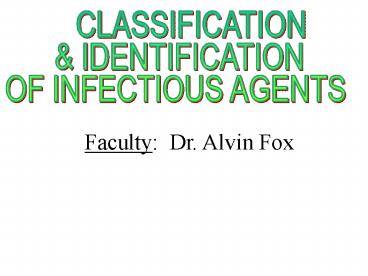Faculty: Dr' Alvin Fox - PowerPoint PPT Presentation
1 / 27
Title:
Faculty: Dr' Alvin Fox
Description:
Steps in isolation and identification. Step 1. Streaking culture plates ... Serologic identification. antibody response to the infecting agent ... – PowerPoint PPT presentation
Number of Views:92
Avg rating:3.0/5.0
Title: Faculty: Dr' Alvin Fox
1
CLASSIFICATION IDENTIFICATION OF
INFECTIOUS AGENTS
Faculty Dr. Alvin Fox
2
Key Terms
- Isolation (culture)
- Agar plate/colonies
- Liquid media test tube - bulk
- Biochemical (physiological) tests
- Molecular tests
- DNA-DNA homology
- 16S rRNA sequencing
- Chemical profiling
- Non culture based detection
- Polymerase chain reaction- (PCR)
- Agglutination (antigen detection)
- Stain
- Serology (antibody detection)
- Identification taxonomy
- Family
- Genus
- Species
- Type
- Strain
3
Identification in the diagnostic laboratory
- Aids treatment
- Susceptibility antibiotic selection
- Based on taxonomy
- Simple, low cost, rapid
4
Classification
- Strain one single isolate or line
- Species related strains
- Type sub-set of species
- Genus related species
- Family related genera
5
Steps in isolation and identification
- Step 1. Streaking culture plates
- colonies on incubation (e.g 24 hr)
- size, texture, color, hemolysis
- oxygen requirement
6
Blood Agar Plate
7
Isolation and identification
- Step 2. Colonies Gram stained
- cells observed microscopically
8
Gram Stain
Gram negative
Gram positive
Heat/Dry
Crystal violet stain
Iodine Fix
Alcohol de-stain
Safranin stain
9
Gram stain morphology
- Shape
- cocci (round)
- bacilli (rods)
- spiral or curved (e.g. spirochetes)
- Single or multiple cells
- clusters (e.g. staphylococci)
- chains (e.g. streptococci)
- Gram positive or negative
10
(No Transcript)
11
(No Transcript)
12
Step 3. Isolated bacteria are speciated
- Generally using physiological tests
13
Typical Culture Laboratory Bench
14
Step 4. Antibiotic susceptibility testing
15
Antibiotic susceptibility testing
Susceptible
Not susceptible
Bacterial lawn
Growth
No growth
Antibiotic disk
16
Taxonomic characterization of bacteria
- Based on molecular or chemical analysis
- Species comparisons involving multiple strains
17
Molecular analysis
- Historical
- guanine (G) cytosine (C) ( GC)
- Now
- Hybridization
- Gene characterization
- sequencing
- other
18
DNA-DNA hybridization
Strain 1
Heat
Strain 2
0 Homology
100 Homology
19
DNA-DNA hybridization
- Groups bacterial strains into species
- Below species level
- little or no relatedness
20
16S rRNA Sequencing
- similarity above species level
- allows relatedness comparisons of all bacteria
- closely related bacterial species may be
identical - development of clinical tests based on sequence
21
Structural profiles
- long chain fatty acids
- widely used
- carbohydrates
- ubiquinones
22
- Metabolic profiles
- volatiles
- alcohols
- short chain fatty acids
23
Rapid diagnosis without culture
- WHEN AND WHY?
- grow poorly
- isolation
- slow
- may not be clinically useful
- can not be cultured
- isolation impossible
24
Rapid Strep Test
Streptococcal antigenic extract
Antibody
Latex beads
25
Bacterial DNA sequences amplified directly from
human body fluids
- Polymerase chain reaction (PCR)
- Great success in rapid diagnosis
- of tuberculosis.
26
Microscopy
- spinal fluids (meningitis)
- sputum (tuberculosis)
- sensitivity poor
27
Serologic identification
- antibody response to the infecting agent
- several weeks after an infection has occurred































